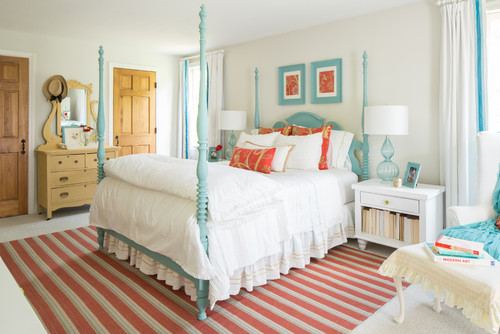Whether you are concerned about child labor, fair wages, human rights, or environmental impacts there is a lot to think about if you are trying to purchase a product you feel confident was made in an ethical way. In today's consumer society most buyers are looking for cheap, fast, and easy, which can be the enemy of ethically made products. But, there are still those who want to take the time and use their money to make a positive impact, and promote a healthier world for all.
Unfortunately, there is no one simple answer for all of us, this blog hopes to provide a jumping off point for those of you who wish to delve deeper into making sure you are making a purchase you feel good about. Each of us has our very own set of values and beliefs, making certain specific ethical concerns very individual. While we at Bradford's Rug Gallery try to be as knowledgeable as possible about the different companies we work with and the products they provide, including their environmental and social impacts, we cannot possibly know the answers to all specific ethical concerns because of their subjective nature. What we can do is use our vast knowledge to direct you once you have identified your personal ethical concerns and have determined exactly what you are looking for.

Photos courtesy: 
Below are some of the most common ethical concerns we hear our customers voice, as well as resources to help you educate yourself more on buying products that you can really feel confident align with your personal set of ethics.
Made Without Child Labor:
Child labor has historically been prolific in the textile industry. Part of the challenge of eliminating illegal child labor has been the international nature of the carpet industry and the difficulty of monitoring every single manufacturer - from large weaving facilities with hundreds of looms down to cottage industry weaving facilities with 3 or 4 looms - in multiple countries. There are also the challenges of addressing cultural differences. Carpet production and the use of child weavers on family looms has a long and legal tradition in India and Pakistan dating back to the 15th century. As UNICEF points out - not all child labor is bad or illegal.
'Not all child labour is bad, because day-to-day child co-operation is for many families a necessity to survive.'
- UNICEF -
There are several organizations that have stepped up to combat the issue of child labor in rug production. The Oriental Rug Importers Association (ORIA) is a national trade association that was formed in 1958 to foster ethical business practices in the United States and the oriental rug making countries.
The ORIA is absolutely opposed to the use of illegal child labor and, accordingly, their members have taken affirmative steps to avoid the procurement of carpets made with illegal child labor. The ORIA members, through the ORIA Charitable Fund, have committed funds to assist with schools in Pakistan and India. There is a clear link between child labor and a lack of available education, providing children with the alternative of schooling helps eliminate illegal child labor practices.
'Wherever the social situation has improved and children have had a school they could attend, child labour has disappeared.'
- TERRE DES HOMMES -
ORIA membership includes area rug importers and manufacturers all of the rug companies that we at Bradford's Rug Gallery purchase from. To learn more in detail about ORIA's stance on child labor please read their position paper:
ORIA Position Paper on Child Labor
Also combating child labor is the European based organization Care & Fair. They are an alliance of retailers, importers and exporters that has been committed to creating humane living conditions in carpet knotting regions, especially for the youngest members of those societies. The focus of their work includes abolishing illegal child labor in India and Pakistan, creating better living conditions for carpet knotting families, producing goods in a socially acceptable manner, and being a positive example for others to follow. ORIA is a member/sponsor of the Care & Fair organization. While ORIA has no certifying logo - members of Care & Fair have the ability to use their logo as a certifier of products made without illegal child labor. If a rug has a Care & Fair tag you can be sure it was made without child labor, but on the flip side a rug does not have to have a Care & Fair tag to still be assured that it was made without child labor. The best way to know for sure is ask your retailer (that's us!) or look at the ORIA member list to see whether the manufacturer of you rug is a member - if they are you can be assured your rug was made without child labor.
Environmentally Friendly:
There are many different ways in which to look at the environmental friendliness of a product: How was product the made? What is it made of? What happens to it after it is thrown it away? What are the environmental impacts of the harvesting and processing of the core materials? Is it energy or water intensive to produce? What is the intended life span of the product? Does it contain any harmful chemicals? Does it require harmful chemicals to clean it?
To find a truly eco-friendly product you would want to consider all of those questions at the same time. "A life cycle assessment, or LCA, identifies opportunities for quantifying the impacts that a product has on the environment throughout its full life cycle – from production and manufacturing to the disposal phase. A full LCA is also known as a “Cradle to Grave” sustainability assessment." - Heritage Paper Blog
"'Cradle to Grave' thinking not only considers the impact of products during their use or disposal stages, but introduces the fact that many products have significant impacts throughout their entire lives. Beginning with the extraction of the raw materials that actually comprise the product, to its manufacturing, use of energy and water, its waste and emissions, transportation impacts, the actual use of the product and finally, ending with the ultimate disposal of the product — thus, from cradle to grave." - cleanlink.com
Whether you are looking for a product that contains no chemicals or you are looking to find a product that adheres to the "cradle to grave" principles we will use our knowledge of our products to best to direct you to a product that meets your needs.
At Bradford's Rug Gallery we are fond of wool for many reasons (which is why we primarily carry wool products), but from the environmental perspective it is a particularly eco-friendly product. Recent research conducted by the wool industry shows that wool’s environmental footprint is low when it comes to the consumption of energy and water during the consumer use phase. This makes wool products more sustainable compared to other fiber products. Wool is a durable, renewable, biodegradable, stain resistant, and fire resistant material. It requires no flame retarding chemicals like all synthetic (man-made) materials do.

In the textile industry the most energy, water, and pollutant intensive process is dyeing, especially dyeing with synthetic dyes. Buying rugs made with natural dyes or with yarns that are un-dyed will drastically reduce the negative environmental impacts of an area rug. To view some rugs made with un-dyed yarns click here.
It is also important to consider that buying a vintage or antique rug may be the most eco-friendly choice you could make. Choosing an existing product eliminates any environmental impacts of production and lessens the disposal impacts as well. Remember, the 3 R's: Reduce, REUSE, and Recycle. Check out our Vintage and Antique collections here.
Further Resources:
For additional reading on ethical concerns specifically related to the rug industry and beyond please explore the following websites:
-
UNICEF works in 190 countries and territories to save children’s lives, to defend their rights, and to help them fulfil their potential, from early childhood through adolescence.
- While child labor has historically been prevalent in the textile industry, children are exploited in many other industries, such as sugarcane, banana, and flower production. For more information please visit the International Labor Organization website and learn about their International Programme on the Elimination of Child Labor.
- For more information on the environmental and ethical impacts of wool please visit the International Wool Textile Organization website.
- If you are interested in the environmental impacts of the textile industry check out the following article: Clothing to dye for: the textile sector must confront water risks. - The Guardian
-
In their 2002 book Cradle to Cradle: Remaking the Way We Make Things, architect William McDonough and chemist Michael Braungart presented an integration of design and science that provides enduring benefits for society from safe materials, water and energy in circular economies and eliminates the concept of waste.
-
In the news today we're hearing a lot about PFAS. Per- and polyfluoroalkyl substances (PFAS) are a group of man-made chemicals that have been in use since the 1940s, and are (or have been) found in many consumer products like cookware, food packaging, and stain repellants (especially prevalent in textiles). For more information visit the following EPA weblinks: Basic information on PFAS and https://www.epa.gov/pfas
Continue reading





































